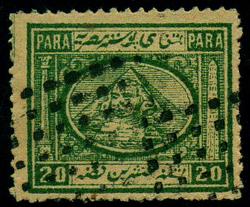







Return To Catalogue - Egypt 1867 types - Egypt 1866 issue - Egypt 1872 issue - Egypt 1879-1920 - Miscellaneous - Suez Canal Company
Note: on my website many of the
pictures can not be seen! They are of course present in the cd's;
contact me if you want to purchase them: evert@klaseboer.com.
5 pa yellow
10 pa lilac
20 pa green
1 Pi red
2 Pi blue
5 Pi brown ('P' and 'E' in upper corners)
For the specialist: A star and crescent is impressed on the backside of the stamp (sort of watermark), checking this is the easiest way of detecting forgeries! The absence of this impression guarantees that the stamp is a forgery (forgeries with watermark also exist though). Four types of each of these stamps exist. The stamps were perforated 15 x 12 1/2. They were printed in sheets of 200 stamps (10 x 20).

Watermark seen from the backside of a 5 pa yellow stamp, reduced
size
Value of the stamps |
|||
vc = very common c = common * = not so common ** = uncommon |
*** = very uncommon R = rare RR = very rare RRR = extremely rare |
||
| Value | Unused | Used | Remarks |
| 5 pa | ** | ** | |
| 10 pa | ** | ** | |
| 20 pa | *** | ** | |
| 1 Pi | * | c | |
| 2 Pi | *** | ** | |
| 5 Pi | R | *** | |

10 pa value with an 'extra Arabic sign' at the bottom, central
right.
Four types of each of these stamps exist. Compare the Egyptian inscriptions of the 4 types of each stamp, also compare the numbers in the bottom corners. For images see Egypt 1867 types

Mute cancel, consisting of a pattern of dots to form a lozenge.
According to http://www.egyptstudycircle.org.uk/post_marks.html
this cancel is called a 'Retta cancel'. They were first seen in
1866 to cancel the stamps. Later on they were merely used to
cancel stamps that didn't receive a normal cancel (for example on
letters originating from ships). Don't confuse this cancel with
the dots cancels of many of the forgeries.








Different types with space of the bottom '5's larger in the 5 Pi
and this space smaller in the 5 pa (opposite to the genuine
stamps).
In these forgeries the head of the sphinx almost touches the outlines of the front face of the pyramid. Furthermore the cancel, dots in a square, was never used on the genuine stamps. The above forgeries are made by the Spiro brothers. Note the larger space for the '5's in one of the 5 Pi forgeries (the forger made a mistake and took the bottom frame of the 5 pa). All these forgeries are also discussed in 'The Spud Papers IX and X'. These forgeries also exist with a circular cancel consisting of an unreadable text with 'VF' in the center (as in the 2 pi above).
Other forgeries:
The above forgeries seem to have an impressed(?)
watermark. Note that the value inscription differs considerably
from the genuine stamps. The colours seem to be very bright. I
have also seen whole sheets of these forgeries (5 p and 10 p)
with 42 stamps (6 rows of 7 stamps) with part of the border of
the sheet in the same colour as the stamps (the above forgeries
are all at the border).
The 2 Pi value always appears to have blue smudges in the lower
left part of the ellipse.
The 5 Pi value has the bottom spaces for the '5's too large (the
bottom spaces of the 5 pa value has been copied).

Page from a Fournier Album with Fournier forgeries.

(This could be a Fournier forgery?)

Some primitive forgeries on hard paper, reduced sizes.


Another very dubious 5 pa stamp and 2 Pi stamp.

20 pa with curved bottoms of the two and a bogus Papal States
alike cancel.

Another forgery with curved '2's, but different from the above
forgery.

Forgery with a bogus cancel consisting of four concentric rings
with a number (6...?).


Another forgery of the 5 Pi value.

A pair of two 10 pa forgeries with forged cancel.

Essay of a 1 Pi stamp, different design. I've also seen this
value imperforate (1 Pi) in red. I've also seen a brown
imperforate proof without any inscription on top or bottom.
I have seen an imperforate 'proof' of these stamps in a slightly different design with inscription 'POSTE EGIZIANE' at the sides; the 1 Pi in the colours green and red (the ellipse with the sphinx in red); these proofs are actually forgeries. I've also seen 1 Pi blue and brown, 1 Pi green and violet, 1 Pi yellow and black, 1 Pi red and violet, 1 Pi blue and red and finally 1 Pi brown and red. Example:


Highly dubious item, with 'POSTE EGIZIANE PORTO SAID 3 GEN 78 T1'
cancel, which can also be found on many forged postage due
stamps.
For Egypt 1872 issue, click here.